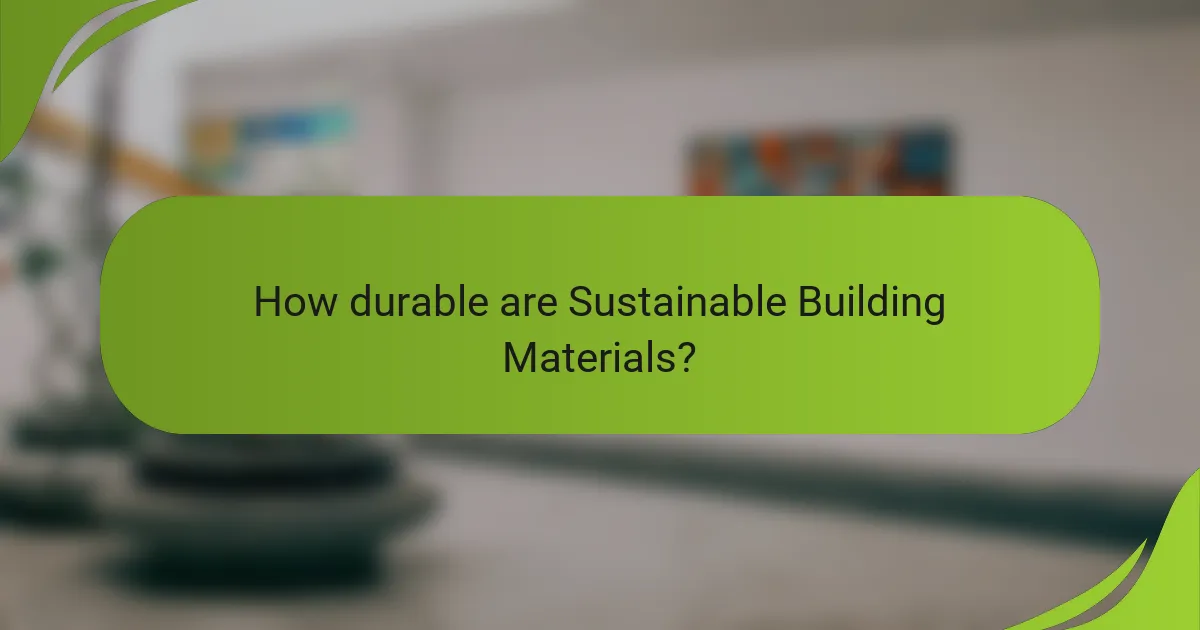Sustainable building materials are environmentally friendly resources designed to minimize negative impacts on ecosystems while enhancing construction practices. These materials, which include bamboo, reclaimed wood, and recycled metal, are sourced from renewable or recycled origins, contributing to waste reduction and resource conservation. The benefits of using sustainable materials include improved indoor air quality, lower energy consumption, reduced carbon footprints, and increased property value. Additionally, these materials are known for their durability, often matching or exceeding the strength and longevity of conventional options, thereby supporting effective and sustainable construction practices.

What are Sustainable Building Materials?
Sustainable building materials are resources that are environmentally friendly and designed to minimize negative impacts on ecosystems. These materials often come from renewable sources or are recycled, reducing waste and conserving natural resources. Examples include bamboo, reclaimed wood, and recycled metal. According to the U.S. Green Building Council, sustainable materials can improve indoor air quality and reduce energy consumption. Their use contributes to the overall sustainability of construction projects and supports a circular economy.
How do Sustainable Building Materials differ from traditional materials?
Sustainable building materials differ from traditional materials primarily in their environmental impact and resource efficiency. Sustainable materials are often derived from renewable resources, such as bamboo or recycled steel. These materials reduce waste and minimize the carbon footprint associated with their production. Traditional materials, like concrete and virgin wood, often rely on non-renewable resources and have higher embodied energy.
For example, the production of concrete generates significant CO2 emissions, while sustainable alternatives can mitigate this impact. Additionally, sustainable materials typically promote better indoor air quality by using non-toxic substances. This contrasts with many traditional materials that may release harmful VOCs. Overall, the key differences lie in sustainability, resource use, and environmental health impacts.
What are the key characteristics of Sustainable Building Materials?
Sustainable building materials are defined by their minimal environmental impact and resource efficiency. They are sourced from renewable resources or recycled materials. Their production processes typically consume less energy compared to conventional materials. These materials often contribute to better indoor air quality by using non-toxic components. They also have a long lifespan, reducing the need for frequent replacements. Sustainable building materials can include bamboo, recycled metal, and reclaimed wood. Their use supports sustainable construction practices and reduces carbon footprints. According to the U.S. Green Building Council, sustainable materials can significantly lower energy consumption in buildings.
Why is the choice of materials important in construction?
The choice of materials is crucial in construction because it directly affects the structure’s durability, safety, and environmental impact. Selecting appropriate materials ensures that buildings withstand various stresses, such as weather and loads. For instance, concrete and steel are often chosen for their strength and longevity. Additionally, materials influence energy efficiency and sustainability. Using eco-friendly materials reduces the carbon footprint of construction projects. Research indicates that sustainable materials can lower energy consumption by up to 30% over a building’s lifetime. Therefore, the right material choice is essential for achieving structural integrity and environmental responsibility.
What are the primary types of Sustainable Building Materials?
The primary types of sustainable building materials include bamboo, recycled steel, reclaimed wood, and straw bales. Bamboo is a fast-growing grass that offers high strength and flexibility. Recycled steel reduces the need for new metal production, conserving resources. Reclaimed wood repurposes old timber, minimizing waste and preserving forests. Straw bales provide excellent insulation and are biodegradable. Each of these materials contributes to reducing environmental impact and promoting sustainability in construction.
What are the benefits of using recycled materials in construction?
Using recycled materials in construction reduces environmental impact and conserves natural resources. Recycled materials lower the demand for new raw materials. This process decreases energy consumption during production. It also minimizes waste sent to landfills, promoting sustainability. Studies show that using recycled content can reduce greenhouse gas emissions significantly. For example, the U.S. Environmental Protection Agency reports that recycling construction materials can save 1.1 billion tons of carbon dioxide emissions annually. Additionally, incorporating recycled materials can lower construction costs. It often leads to innovative design solutions and improved building performance. Overall, the benefits of using recycled materials enhance sustainability in the construction industry.
How do natural materials contribute to sustainability?
Natural materials contribute to sustainability by reducing environmental impact and promoting resource efficiency. They are often biodegradable and can be sourced locally, minimizing transportation emissions. Natural materials, such as wood, bamboo, and straw, require less energy to process compared to synthetic alternatives. Their use in construction lowers carbon footprints and enhances indoor air quality. Studies show that buildings made from natural materials can lead to significant energy savings over their lifecycle. For example, wood sequesters carbon, helping to mitigate climate change. Additionally, natural materials often have lower toxicity levels, benefiting human health and ecosystems.

What are the benefits of using Sustainable Building Materials?
Sustainable building materials offer numerous benefits. They reduce environmental impact by minimizing resource depletion. These materials often have lower carbon footprints compared to conventional options. They contribute to energy efficiency in buildings, leading to lower utility bills. Sustainable materials can enhance indoor air quality by reducing harmful emissions. They often require less maintenance, which can lower long-term costs. Additionally, using these materials can increase property value due to rising demand for eco-friendly structures. Studies show that buildings using sustainable materials can significantly reduce waste generation during construction.
How do Sustainable Building Materials impact energy efficiency?
Sustainable building materials enhance energy efficiency by reducing energy consumption during construction and throughout a building’s lifecycle. These materials often possess superior insulation properties, minimizing the need for heating and cooling. For example, materials like straw bales and rammed earth can significantly lower energy demand. Additionally, sustainable materials reduce the carbon footprint associated with energy production. According to the U.S. Department of Energy, using energy-efficient materials can lead to a 30% reduction in energy costs. This efficiency is further supported by the use of renewable resources, which are often abundant and locally sourced, decreasing transportation energy. Overall, sustainable building materials contribute to a more energy-efficient built environment.
What role do insulation materials play in energy savings?
Insulation materials significantly reduce energy consumption in buildings. They minimize heat transfer between the interior and exterior. This helps maintain a stable indoor temperature. Consequently, less energy is required for heating and cooling. Studies show that proper insulation can reduce energy bills by up to 30%. Materials like fiberglass, foam, and cellulose are commonly used for their thermal resistance. The effectiveness of insulation is measured by its R-value, which indicates resistance to heat flow. Higher R-values correlate with greater energy savings. Thus, insulation materials play a crucial role in enhancing energy efficiency in buildings.
How can Sustainable Building Materials reduce utility costs?
Sustainable building materials can reduce utility costs by enhancing energy efficiency. These materials often have superior insulation properties. For example, using recycled steel and bamboo can lower heating and cooling expenses. Additionally, sustainable materials can improve the overall durability of buildings. This leads to less frequent repairs and replacements, further reducing costs. According to the U.S. Department of Energy, energy-efficient buildings can save up to 30% on energy bills. Therefore, the use of sustainable building materials directly correlates with lower utility expenses over time.
What health benefits are associated with Sustainable Building Materials?
Sustainable building materials contribute to improved indoor air quality. They often contain fewer volatile organic compounds (VOCs) compared to conventional materials. This reduction in VOCs leads to lower risks of respiratory issues and allergies. Sustainable materials also promote better thermal comfort, which can enhance overall wellbeing. For example, materials like bamboo and reclaimed wood regulate humidity effectively. Additionally, these materials can be sourced locally, reducing transportation emissions. Studies show that healthier indoor environments can boost productivity by up to 15%. Overall, using sustainable building materials supports both environmental health and human health.
How do these materials improve indoor air quality?
Sustainable building materials improve indoor air quality by reducing harmful emissions and enhancing ventilation. These materials often have low volatile organic compounds (VOCs), which minimizes toxic off-gassing. For example, natural materials like bamboo and cork emit fewer pollutants compared to synthetic options. Improved air quality is also achieved through better moisture control, which helps prevent mold growth. Studies show that using low-emission materials can significantly lower indoor air pollution levels. Enhanced air quality contributes to better health outcomes for occupants. Thus, sustainable materials play a crucial role in creating healthier indoor environments.
What are the implications for occupant comfort and well-being?
Sustainable building materials significantly enhance occupant comfort and well-being. These materials often have better thermal insulation properties, leading to stable indoor temperatures. Improved air quality is another benefit, as many sustainable materials emit fewer volatile organic compounds (VOCs). This results in healthier environments, reducing respiratory issues among occupants. Additionally, natural materials can enhance acoustic performance, minimizing noise pollution. Studies show that occupants in sustainably built environments report higher satisfaction levels. For instance, a study by the University of California found that occupants in green buildings reported a 20% increase in overall comfort. These factors collectively contribute to improved mental and physical well-being for occupants.

How durable are Sustainable Building Materials?
Sustainable building materials are generally highly durable. Many sustainable materials, such as bamboo, reclaimed wood, and recycled metal, exhibit strength comparable to traditional materials. For instance, bamboo can withstand heavy loads due to its tensile strength. Additionally, reclaimed wood is often more stable than new wood due to its age and seasoning. Research shows that materials like straw bales can last over 50 years when properly maintained. Furthermore, concrete made with recycled aggregates has demonstrated similar longevity to conventional concrete. Overall, the durability of sustainable materials contributes to their effectiveness in construction.
What factors influence the durability of Sustainable Building Materials?
The durability of sustainable building materials is influenced by several key factors. These factors include material composition, environmental conditions, and maintenance practices. Material composition refers to the types of raw materials used, such as recycled content or natural fibers. High-quality, resilient materials typically exhibit greater durability. Environmental conditions encompass exposure to moisture, temperature fluctuations, and UV radiation. These elements can significantly affect the lifespan of materials. Maintenance practices, such as regular inspections and repairs, also play a critical role in preserving durability. Studies indicate that sustainable materials, when properly maintained, can outperform traditional materials in longevity.
How do climate and environmental conditions affect material longevity?
Climate and environmental conditions significantly affect material longevity. Extreme temperatures can cause expansion and contraction in materials, leading to structural weaknesses. High humidity levels can promote mold and decay in organic materials. UV radiation can degrade plastics and coatings, reducing their lifespan. Additionally, exposure to pollutants can corrode metals and other materials. For instance, concrete can deteriorate faster in coastal areas due to salt exposure. Weathering processes, such as wind and rain, also contribute to material wear over time. Studies show that materials designed for specific climates tend to last longer than those that are not.
What maintenance practices enhance the durability of these materials?
Regular cleaning and inspection enhance the durability of sustainable building materials. Cleaning removes dirt and contaminants that can degrade materials over time. Inspections identify wear and damage early, allowing for timely repairs. Proper sealing protects against moisture intrusion, which can lead to rot or mold. Applying protective coatings can extend the life of surfaces exposed to weather. Routine maintenance schedules help ensure consistent care and longevity. Following manufacturer guidelines for specific materials is crucial for optimal performance. Research shows that proactive maintenance can significantly reduce the need for costly replacements.
How do Sustainable Building Materials perform over time compared to traditional materials?
Sustainable building materials generally perform better over time compared to traditional materials. They often exhibit superior durability and resilience. For example, materials like bamboo and recycled steel can withstand environmental stressors effectively. Studies show that sustainable materials can have a lifespan that exceeds that of conventional materials by up to 20%. Additionally, they tend to require less maintenance, reducing long-term costs. Research from the University of Cambridge indicates that buildings using sustainable materials show lower degradation rates. This leads to increased overall performance and longevity.
What are the long-term cost benefits of using durable materials?
Using durable materials leads to significant long-term cost benefits. These materials reduce the frequency of repairs and replacements. For instance, high-quality roofing can last 30 years or more, unlike cheaper alternatives that may need replacement in 10 years. This longevity translates into lower maintenance costs over time. Additionally, durable materials often enhance energy efficiency. For example, insulated windows can decrease heating and cooling expenses by up to 25%. Investing in durable materials can also increase property value. Homes built with resilient materials often attract higher resale prices. Overall, the initial investment in durable materials pays off through reduced long-term expenses and increased property value.
How does durability contribute to overall sustainability in construction?
Durability significantly contributes to overall sustainability in construction by extending the lifespan of buildings and materials. When construction materials are durable, they require less frequent replacement. This reduces resource consumption and waste generation over time. According to the U.S. Environmental Protection Agency, the construction and demolition sector accounts for about 25-30% of total waste in landfills. Durable materials help mitigate this impact. Additionally, durable buildings often have lower maintenance and repair needs, which translates to reduced energy and material use over their lifecycle. Research from the National Institute of Standards and Technology indicates that enhancing the durability of building materials can lead to significant reductions in environmental impacts. Thus, durability is a key factor in promoting sustainable construction practices.
What is the environmental impact of Sustainable Building Materials?
Sustainable building materials significantly reduce environmental impact. They minimize resource depletion by using renewable or recycled resources. These materials often have lower carbon footprints compared to conventional options. For instance, bamboo grows rapidly and absorbs more CO2 than many trees. Sustainable materials also promote energy efficiency in buildings, reducing overall energy consumption. According to the U.S. Green Building Council, buildings account for 39% of carbon emissions. Utilizing sustainable materials can help mitigate this issue. Additionally, they often contribute to improved indoor air quality. This is due to lower levels of volatile organic compounds (VOCs). Overall, sustainable building materials play a crucial role in promoting environmental sustainability.
What practices can maximize the sustainability of building projects?
Utilizing sustainable building materials maximizes the sustainability of building projects. This includes selecting materials with low environmental impact. Examples are recycled materials and sustainably sourced timber. Implementing energy-efficient designs further enhances sustainability. This can involve passive solar design and high-performance insulation. Incorporating renewable energy sources is also critical. Solar panels and wind turbines can reduce reliance on non-renewable energy. Efficient water management practices contribute significantly as well. Rainwater harvesting and greywater recycling can minimize water usage. Finally, engaging in life cycle assessment can identify opportunities for improvement. This ensures that all phases of a building’s life are considered for sustainability.
How can builders choose materials that align with sustainability goals?
Builders can choose materials that align with sustainability goals by evaluating their environmental impact. They should prioritize materials with low embodied energy, which refers to the total energy required for extraction, processing, and transportation. Sustainable materials often include recycled content, which reduces waste and conserves resources. Builders can also select locally sourced materials to minimize transportation emissions. Certifications like LEED or FSC can guide builders in identifying sustainable options. Research shows that using sustainable materials can reduce a building’s carbon footprint by up to 30%. Additionally, builders should consider the durability and lifecycle of materials to ensure long-term sustainability.
What certifications should be considered when selecting Sustainable Building Materials?
When selecting sustainable building materials, consider certifications such as LEED, FSC, and Green Seal. LEED (Leadership in Energy and Environmental Design) evaluates building projects for their environmental performance. The Forest Stewardship Council (FSC) certification ensures that wood products come from responsibly managed forests. Green Seal certification focuses on products that meet rigorous environmental standards. These certifications help verify that materials are sustainable and environmentally friendly. They provide assurance to builders and consumers about the ecological impact of their choices.
How can I implement Sustainable Building Materials in my next project?
To implement sustainable building materials in your next project, start by researching available options. Consider materials like bamboo, recycled steel, and reclaimed wood. Evaluate their environmental impact and durability. Source materials from local suppliers to reduce transportation emissions. Incorporate energy-efficient insulation and low-VOC paints. Use life cycle assessment tools to compare the sustainability of different materials. Collaborate with architects and contractors experienced in sustainable practices. Ensure compliance with green building certifications such as LEED or BREEAM. Implementing these steps can significantly enhance your project’s sustainability.
Sustainable building materials are environmentally friendly resources designed to minimize negative impacts on ecosystems, often sourced from renewable or recycled origins. This article covers the differences between sustainable and traditional materials, highlighting their key characteristics, benefits, and implications for energy efficiency and indoor air quality. It also examines the durability of sustainable materials, factors influencing their longevity, and practices to maximize sustainability in construction projects. Additionally, the article discusses certifications for sustainable materials and provides guidance on implementing these materials in future building endeavors.